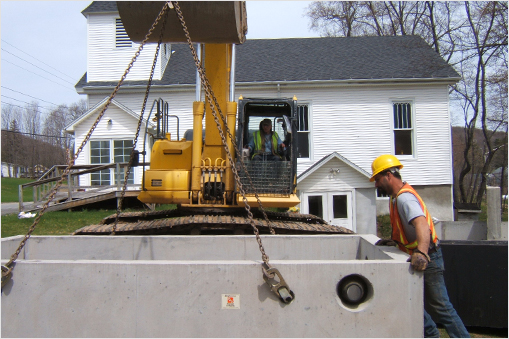 May 15, 2014 CONTACT: CWC (845) 586-1400 x. 306; DEP (845) 334-7868 Extension of Sewer System in Trout Creek Will Help to Protect New York City WatershedThe Catskill Watershed Corporation (CWC) and New York City Department of Environmental Protection (DEP) today announced that the installation of new septic tanks and lateral pipes to connect 55 buildings to the Trout Creek Community Wastewater Treatment System in the Town of Tompkins, Delaware County began April 28. A $6.5 million block grant from the DEP is funding the project, which is being coordinated by the Catskill Watershed Corporation’s Community Wastewater Management Program (CWMP). “These projects have saved Watershed homeowners hundreds of thousands of dollars and a lot of inconvenience,” said CWC Executive Director Alan Rosa. “They’ve also made our small towns more appealing to people who are looking for a community to start or relocate a new business.” “Ensuring that wastewater is collected and treated through reliable infrastructure is an important part of New York City’s watershed protection programs, which allow the city to maintain the largest unfiltered water supply in the country,” said DEP Commissioner Emily Lloyd. “Thanks to our partnership with CWC, thousands of new septic systems and community wastewater solutions have been installed to protect water quality and support homeowners and businesses in the Catskills.” The project is intended to properly treat wastewater in the hamlet of Trout Creek, which is situated on the stream of the same name. This system sewers the hamlet around the intersection of State Route 206 and County Route 27, approximately three miles north of New York City’s Cannonsville Reservoir. Fifty substandard septic tanks, pits and cesspools on individual properties will be filled in and replaced with new concrete tanks where solids will be retained and periodically removed. Liquids will be conveyed to a series of absorption beds. There the wastewater will be purified by naturally filtering back into the soil. Four grease traps will also be installed at community buildings. Five existing septic tanks are in good condition and will not be replaced. This is the seventh CWMP project coordinated in the New York City West-of-Hudson Watershed by the CWC and designed by Lamont Engineers. Communities with new wastewater systems established under this program include Ashland in Greene County, Bovina, Bloomville, Hamden and Delancey in Delaware County, and Boiceville in Ulster County. Projects range from septic maintenance districts to full scale wastewater treatment plants. They have resulted in the decommissioning of 367 on-site septic systems, and the ongoing maintenance of 156 others, thereby preserving water quality while providing peace of mind to homeowners who no longer have to worry about troublesome septic issues. The collection system and the three absorption bed sites of this small diameter treatment system were completed in 2013 by LaFever Excavating of Bovina which is also installing the tanks and laterals. Other area contractors and suppliers employed on the project include Butts Concrete of Masonville, Trimbell Electric of Bovina, Blake Equipment of Oneonta and Binghamton Precast. The CWC is a non-profit, Local Development Corporation responsible for several environmental protection, economic development and education programs in the New York City Watershed West of the Hudson River. Visit cwconline.org for more information. DEP manages New York City’s water supply, providing more than one billion gallons of high quality water each day to more than 9 million New Yorkers. This includes more than 70 upstate communities and institutions in Ulster, Orange, Putnam and Westchester counties who consume an average of 110 million total gallons of drinking water daily from New York City’s water supply system. This water comes from the Catskill, Delaware, and Croton watersheds that extend more than 125 miles from the City, and the system comprises 19 reservoirs, three controlled lakes, and numerous tunnels and aqueducts. DEP has nearly 6,000 employees, including almost 1,000 scientists, engineers, surveyors, watershed maintainers and others professionals in the upstate watershed. In addition to its $70 million payroll and $157 million in annual taxes paid in upstate counties, DEP has invested more than $1.7 billion in watershed protection programs—including partnership organizations such as the Catskill Watershed Corporation and the Watershed Agricultural Council—that support sustainable farming practices, environmentally sensitive economic development, and local economic opportunity. In addition, DEP has a robust capital program with nearly $14 billion in investments planned over the next 10 years that will create up to 3,000 construction-related jobs per year. For more information, visit nyc.gov/dep, like us on Facebook at facebook.com/nycwater, or follow us on Twitter at twitter.com/nycwater. | ||